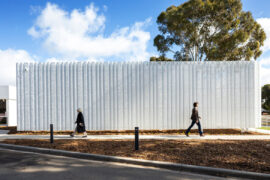Using design thinking to strike a balance between design essentials and practical considerations within healthcare spaces is a timely and important topic. Join us ahead of FRONT.design Forum as we dig into what it means for the industry.

BLP's Austin Health Short Stay Unit. Photo by Ian Ten Seldam.
Humanising healthcare environments can improve both patient and staff wellbeing and is an essential consideration in the design of healthcare spaces. Often, though, hospital designs might cater to the needs of patients but overlook the need for a safe and rejuvenating workplace that serves its staff too.
Book tickets for FRONT.design Forum’s Happy patients, healthy workers panel discussion.
A research report on the topic of Design Matters for Nurses: Hospital design for nurse attraction and retention (HASSELL with University of Melbourne, May 2016) states: “Aesthetics and maintenance of a workplace serve as a daily reminder of the value their employees place on their work. Nurses have identified a number of environmental qualities that affect their daily work experience, including temperature, noise, odour and colour, but the main factors were access to natural light and maintenance.” The report also notes that nurses often complain about the general lack of space away from patient work.
In a recent comment piece for Indesign magazine (Issue 75, November 2018) Michaela Sheahan, senior design researcher at HASSELL commented: “The underestimated value of staff may be more significant than hospital management perceives. But this can be rectified with a renewed focus on the hospital as a workplace, as well as a place to treat patients.”

At the Austin Health Short Stay Unit in Melbourne, BLP has used natural lighting to help with spatial navigation. This ensures both visitors and shift workers can remain connected with everything happening outdoors. Photo by Ian Ten Seldam.
For instance, creating comfortable areas for meal breaks could provide relief from the high-intensity work that hospital staff members have to face every day. Outdoor dining areas for staff members can bring about a sense of enjoyment around mealtimes, creating a substantial distinction between work and break areas. Dedicated spaces for documentation tasks with proper ergonomic support could help reduce strain and fatigue. Even the inclusion of large windows that bring in natural lighting could help impact patient healing and staff wellbeing.
Another emerging trend is using biophilic design principles to craft a more soothing indoor experience. Think improved ventilation, acoustic comfort, enhanced natural lighting, external natural views and the use of natural materials, patterns and colours.

Royal Adelaide Hospital by Silver Thomas Hanley in a joint venture with DesignInc. Photo by Sandor Duzs.
By humanising healthcare spaces through biophilia there is potential to empower patients, aid recovery, reduce stress and improve the emotional wellbeing of staff, in turn creating a more helpful, healing environment. A timely example is the Royal Adelaide Hospital, designed by Silver Thomas Hanley in a joint venture with DesignInc. Planned around landscaped courtyards, the hospital has been conceptualised as a park within a hospital. As Richard Does of DesignInc states in an interview with Indesign magazine (Issue 75, November 2018): “It’s important for designers to visually interpret biophilia in the application of shape, texture and sunlight. RAH’s theme of nature permeates every aspect of design throughout the hospital and its landscape, be it a material pattern, image or form.”

Façade graphics for the Royal Adelaide Hospital by artists Deb Jones, Christine Cholewa and Rachel Harri. Photo by Sandor Duzs.
Perhaps it is worth exploring the idea of design that caters to both the patient and members of staff within a healthcare facility. It is, after all, in a healthcare organisation’s best interests to have a happy and healthy team who love coming in to work and are fully invested in their duties.
This year’s FRONT.design Forum tackles this contentious topic in healthcare design through an illuminating panel talk. Join moderator Tonya Hinde, associate director at Billard Leece Partnership, and panellists Ernest Girardi, managing director, Silver Thomas Hanley, Michaela Sheahan, senior design researcher at HASSELL, and Melina Alushaj, service improvement specialist at Uniting Care.
INDESIGN is on instagram
Follow @indesignlive
A searchable and comprehensive guide for specifying leading products and their suppliers
Keep up to date with the latest and greatest from our industry BFF's!

CDK Stone’s Natasha Stengos takes us through its Alexandria Selection Centre, where stone choice becomes a sensory experience – from curated spaces, crafted details and a colour-organised selection floor.

At the Munarra Centre for Regional Excellence on Yorta Yorta Country in Victoria, ARM Architecture and Milliken use PrintWorks™ technology to translate First Nations narratives into a layered, community-led floorscape.

BLP’s new Sydney Children’s Hospital, Randwick building brings together paediatric care, family-centred design and Australia’s first Children’s Comprehensive Cancer Centre in a major addition to the Randwick Health & Innovation Precinct.

Through expert architecture, EBD Architects has provided a human face to great design and created a project that enhances the lives of people and community.
The internet never sleeps! Here's the stuff you might have missed

We republish an article in memory of the late architect by UTS, whose Dr Chau Chak Wing Building was Gehry’s first built project in Australia. The internationally revered architect passed away on 5th December.

For those who appreciate form as much as function, Gaggenau’s latest induction innovation delivers sculpted precision and effortless flexibility, disappearing seamlessly into the surface when not in use.